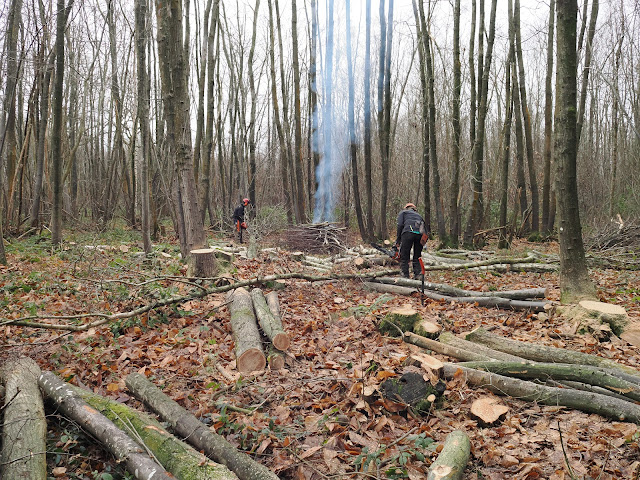Crow Wood is pretty much divided in half by a central track and on one side Scots Pines are the dominant species with Sweet Chestnut on the other. Although the woodland is designated an ancient woodland site neither of these species are very old, both are essentially cash crops, the Scots planted in the 1950s and the Sweet Chestnut in the 1850s, the latter at the peak of the hop industry when thousands of hope poles were required all over Kent. Traditionally the chestnut would have been coppiced (cut back to the ground) every 15 to 20 years and allowed to grow back into the tall straight poles needed in the hop gardens. With the decline in the industry in the 1980s, coppicing largely stopped and many woods like ours held trees that had long grown taller than they should.
These tall "overstood" chestnut trees become prey to strong winds and disease, and create dark shade areas underneath where little ground flora can flourish. Apart from helping the trees to grow again and thus live longer, coppicing is really great for wildlife as the sun can reach the ground giving life again to insects and the plants they need. Since owning the wood one of our aims has been to restart the coppicing cycle again by selecting half acres that are particularly in need of felling. The results do look pretty dramatic but the trees grow back very quickly and without this treatment they would most likely die or suffer wind damage. Come the Spring the cut areas will be full of new growth, feeding birds and buzzing insects.
In early January we were pleased to welcome back our two coppicing experts from Weald Woodscapes. The duo know our wood well, having worked there many times in the past and unlike some contractors we have heard of we know they will do a thorough and sensitive job. The half acre they coppiced created a lot of timber which will be turned into logs or sold to be used as post and rail fencing. Suddenly the wood looks different and we are starting to enjoy the different perspectives. It is pleasing also to continue a woodland management tradition that is several hundred years old.
 |
| the longer poles will be used for post and rail fencing |
 |
| Coppice comes from the French/old English word "couper" to cut |
 |
| watching a Chestnut tree fall safely |
 |
| on the right of the central track is the area of pines with a Beech tree holding on to its leaves in front |
 |
in the spring this will be a sunny ride
|
The weather while the team were working was wet, so conditions were often difficult. Felling such large trees in wet weather can be a very hazardous job in the wrong hands and requires expertise.
A few days later came the cold and snow but the first shoots of Spring are not to be delayed and are beginning to show through. Roll on Spring.












What a lovely blog - thanks
ReplyDelete